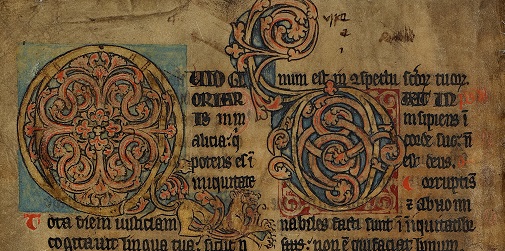The Vatnsfjörður Psalter

The Vatnsfjörður Psalter contains among other things a Latin Office of the Passion (Horae de passione domini) which is illuminated with a series of eight illustrations of Christ’s passion. Click on the image for a larger version.
241 a I fol. is a new shelfmark, created by the division of the original AM 241 a fol. into two numbers, I and II, and the amalgamation of I, a psalter with various additions, and AM 249 p fol., a calendarium. The resulting manuscript can be dated on the evidence of the calendarium to sometime after 1326 but is unlikely to be much younger than that.
A reconstructed psalter
At the time of Árni Magnússon’s death in 1730 AM 241 a fol. (I and II) were a bundle of loosely bound vellum leaves in a somewhat random order, and it was in this state that the manuscript was bound in 1886. Only after Lilli Gjerløw’s reconstruction of the psalter (1980) did it become clear that the original psalter consisted of 88 leaves of which only 35 were preserved, many of which had been clipped. Ten of these 35 leaves have been used in the bindings of other manuscripts in the Arnamagnæan collection. The explanation is clear – the manuscript must already have been defective when Árni Magnússon acquired it, and he therefore had no qualms about using parts of it as bookbinding material after he had removed the calendarium and preserved it along with other similar calendaria. One reason for Árni Magnússon’s greater interest in the calendaria than the liturgical books with which they were originally combined is that they functioned as obituaries: the six preserved leaves in the former AM 249 p fol. contain a number of death notices, added at a later date, of Icelanders from the thirteenth and fourteenth centuries.
Liturgical texts and Christ’s passion
The main part of the manuscript contains the Psalms of David in an extended version with additions of short liturgical texts after every tenth psalm, such as, for example, the Paternoster. The ‘Paternoster Psalter’ must have a special connection to the archdiocese of Nidaros, but although it may have originated in Norway, the vast majority of textual witnesses – all of them fragmentary – are from Iceland. After the psalter itself, the manuscript contains various prayers in Latin or Icelandic, a Latin Office of the Dead with musical notation and last, but not least, a Latin Office of the Passion (Horae de passione domini) which is illuminated with a series of eight illustrations of Christ’s passion.
One hand or two?
The Latin and the Icelandic texts are believed to have been written by the same scribe, who thus mastered both a ‘Latin’ and an ‘Icelandic’ hand. The Icelandic hand has, with a reasonable amount of certainty, been identified with the hand of the Codex Frisianus (AM 45 fol.), but it is uncertain whether the polychrome initials, which are characteristic of both AM 241 a I 4to and AM 45 fol., are the work of the scribe himself and, if so, where this work was carried out – Iceland or Norway. And is it conceivable that there existed in Iceland a scriptorium up to the task of producing the illuminations we find in the Office of the Passion?
The obituaries suggest ownership
A large number of the obituaries in the calendarium concern the family of the Seldælir, to which, among others, Eiríkr Sveinbjarnarson from Vatnsfjörður belonged, and a great deal suggests that Eiríkr, who was possibly Iceland’s most powerful man, at one time owned the manuscript and perhaps even commissioned it. One hypothesis is that the scribe, who can probably be identified with the illuminator, was a certain Þórarinn Eiríksson, nicknamed penturr (the painter), who is known to have visited Vatnsfjörður in 1335 and had an account to settle with Eiríkr Sveinbjarnarson.
Jonna Louis-Jensen

It is uncertain whether the polychrome initials, which are characteristic of both AM 241 a I 4to and AM 45 fol., are the work of the scribe himself and, if so, where this work was carried out. Click on the image for a larger version.
